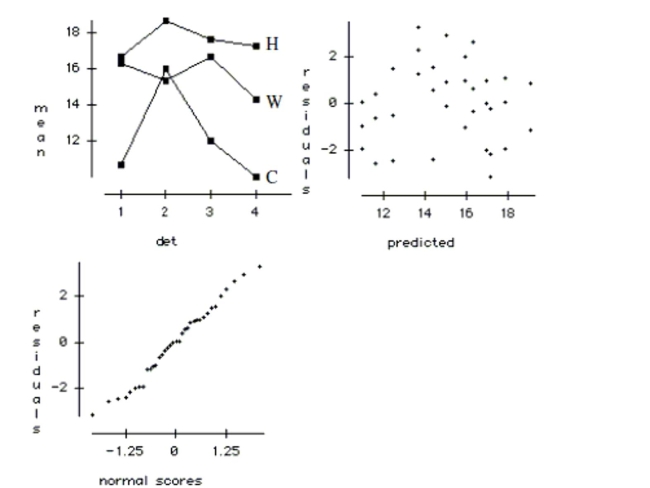For a class project, students tested four different brands of laundry detergent (1, 2, 3, 4) in
three different water temperatures (hot, warm, cold) to see whether their were any
differences in how well the detergents could clean clothes. The students took 36 identical
pieces of cloth and made them dirty by staining them with coffee, dirt, and grass. The 36
pieces were randomly assigned to the 12 combinations of detergent and temperature so
that each combination had 3 replicates. After washing, the students rated how clean the
clothes were from 0 (no change) to 20 (completely spotless). The two factor ANOVA table
is shown below along with an interaction plot and residual plots.

a. Write the hypotheses tested by the Detergent F-ratio. Test the hypotheses and explain
your conclusion in the context of the problem.
b. Write the hypotheses tested by the Temp F-ratio. Test the hypotheses and explain your
conclusion in the context of the problem.
c. Check the conditions required for the ANOVA analysis.
Definitions:
States' Power
Authority or jurisdiction granted to individual states within a federal system, allowing them autonomy in certain matters.
Civil Rights Bill Response
The reaction or actions taken in response to legislation aimed at enforcing or securing civil rights for individuals.
Andrew Johnson
The 17th President of the United States who served from 1865 to 1869, known for his efforts to quickly restore the Southern states to the Union after the Civil War, facing much opposition.
Racial Equality
The principle that individuals should not be discriminated against on the basis of their race and should have equal access to opportunities and rights.
Q29: Exercising Owners of an exercise gym believe
Q60: The standard deviation of the data displayed
Q81: a. Sketch a histogram of these data<br>b.
Q104: Interpret the slope in context.
Q127: If the workers are paid $10/hour, what
Q253: Based on the data they collected during
Q455: State your conclusion.
Q463: The correlation between <span class="ql-formula"
Q600: Grape juice and blood pressure Researchers who
Q784: In an experiment the primary purpose of